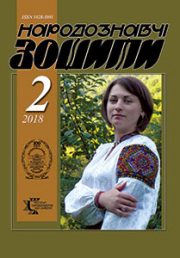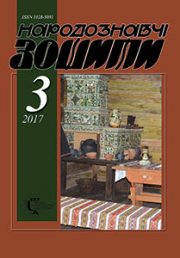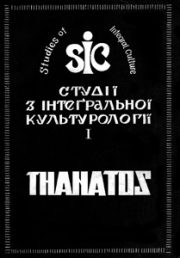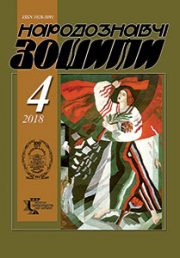The Ethnology Notebooks. 2018, 6 (144), 1394–1412
UDK 398.4:398.33](477.41/.42+476-12)
DOI https://doi.org/10.15407/nz2018.06.1394
Received 21.11.2018
ORCID ID: https://orcid.org/0000-0002-1240-8308
Kovalchuk Nadiia, candidate of sciences in history,
Scientific secretary at the State scientific center
of defence of cultural heritage from technogenic catastrophes,
21 Vyshhorods’ka Str., 04074, Kyiv, Ukraine.
Contacts: Tel.: 0508151794, email.: kovalchuk69@ukr.net; kovalchuk.nadia6@gmail.com
Abstract. Whitsunday tradition of mermaids (rusalky`s) release is considered from the point of view of its local forms of expression and distribution areas on the territory of the Polissia of Ukraine and Belarus. According to the set of ritual actions, the appropriate variants of the custom were found and the geography of their distribution in the southeast of Belarus and in the northeastern part of the Right Bank Polissia and the northwestern part of the Left Bank Polissia of Ukraine was clarified.
Keywords: calendar custom, the Trinity cycle, the release of mermaids, the Polissia of Ukraine, the Polissia of Belarus.
REFERENCES
Materialy kompleksnykh i tematychnykh istoryko-etnohrafichnykh ekspedytsij 1994—2018. In Arkhiv Derzhavnoho naukovoho tsentru zakhystu kul’turnoi spadschyny vid tekhnohennykh katastrof [in Ukrainian].
Vinogradova, L. (1886). Mifologicheskij aspekt polesskoj «rusal’noj» tradicii. In Slavjanskij i balkans’kij fol’klor: Duhovnaja kul’tura Poles’ja na obshheslavjanskom fone (pp. 88—135). Moskva [in Russian].
Vinogradova, L. (2000). Narodnaja demonologija i mifo-ritual’naja tradicija slavjan. Moskva [in Russian].
Halajchuk, V. V. (2008). Demonolohichni uiavlennia naselennia Seredn’oho Polissia pro rusalok. Visnyk L’vivs’koho universytetu. Seriia istorychna, 43, 320—381 [in Ukrainian].
Bidnoshyia, Yu.I. (Ed.). (1996). Hovirka sela Masheve Chornobyl’s’koho rajonu (Ch. 4). Kyiv [in Ukrainian].
Hrytsenko, P.Yu. (Ed.). (1996). Hovirky Chornobyl’s’koi zony: Teksty. Kyiv [in Ukrainian].
Skrypnyk, H. (Ed.). (2016). Etnohrafichnyj obraz suchasnoi Ukrainy. Korpus ekspedytsijnykh fol’klorno-etnohrafichnykh materialiv (Vol. 6). Kyiv [in Ukrainian].
Yefremov, Ye.V. (1997). Rytmostrukturni typy kalendarnykh naspiviv na Kyivs’komu Polissi. In Polissia Ukrainy: materialy istoryko-etnohrafichnoho doslidzhennia (Vyp. I, pp. 245—259). L’viv [in Ukrainian].
Yefremov, Ye.V. (1996). Rusal’ni pisni na Kyivs’komu Polissi. In Polissia: mova, kul’tura, istoriia (pp. 404—411). Kyiv [in Ukrainian].
Novak, V. (Ed.) (2008). Zhawrukovaia pesnia Radzimy: narodnyia dukhownyia skarby Buda-Kashaliowskaha kraiu: manahrafiia. Homel’ [in Belarusian].
Zelenin, D.K. (1995). Izbrannye trudy. Ocherki russkoj mifologii: Umershie neestestvennoj smert’ju i rusalki. Moskva [in Russian].
Koval’chuk, N.A. (2016). Obriad «Provody rusalok» na pivnichnomu skhodi Pravoberezhnoho Polissia (terminy, struktura, arealohiia). Arkheolohiia i davnia istoriia Ukrainy, 3, 197—202 [in Ukrainian].
Kutel’makh, K.M. (2001). Rusalky v povir’iakh polischukiv. In Zapysky Naukovoho tovarystva imeni Shevchenka (Vol. CCXLII, pp. 87—153). L’viv [in Ukrainian].
Novak, V. (Ed.). (2007). Loewshchyna… Bezavyraj, pesennykraj: Suchasny stan tradytsyjnaj kul’tury Loewshchyny. Homel’ [in Belarusian].
Vinogradova, L., & Levkievskaja, E. (Eds.) (2012). Narodnaja demonologija Poles’ja: Publikacii tekstov v zapisjah 80—90-h gg. XX veka (Vol. 2). Moskva [in Russian].
Novak, V., & Koval’, U. (Eds.). (2007). Narodnaia dukhownaia kul’tura Brahinshchyny: fol’klorna-etnahr. zb. Homel’ [in Belarusian].
Novak, V. (Ed.). (2007). Narodnaia dukhownaia spadchyna Homel’skaha raiona. Homel’ [in Belarusian].
Sivitski, U.M. (2006). Rusal’naia tradytsyia belarusaw: mifapaetychnaia sistema, typalahichnyia paraleli. Minsk [in Belarusian].
Tolstaja, S.M. (2005). Polesskij narodnyj kalendar’. Moskva [in Russian].
Valodzina, T. (Ed.). (2012). Tradytsyjnaia mastatskaia kul’tura belarusaw (Vol. 6, Kn. 1). Minsk [in Belarusian].







